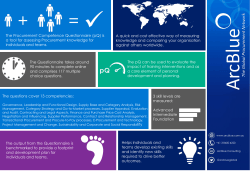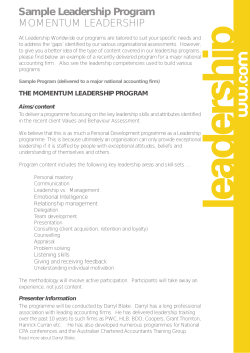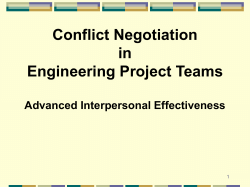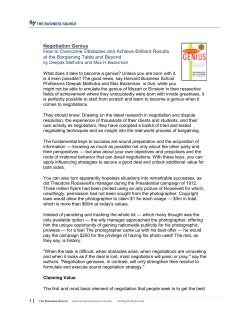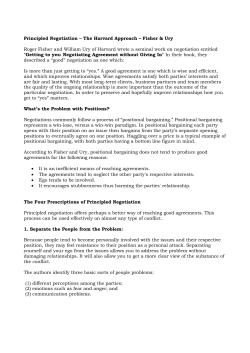
Preface - McGraw Hill Higher Education
Preface Contents v Welcome to the sixth edition of Essentials of Negotiation! Again, this book represents our response to many faculty who wanted a brief version of the longer text. Negotiation (Seventh Edition). The objective of this shorter version is to provide the reader with the core concepts of negotiation in a more succinct presentation. Many faculty requested such a book for use in shorter academic course, executive education programs, or as a companion to other resource materials. It is suitable for courses in negotiation, labor relations, conflict management, human resource management, and the like. Overview of This Book The organization of this volume generally follows the more complete Seventh Edition of Negotiation. The fundamental difference between this and the Seventh Edition text is that this book contains only 12 chapters, while the complete Seventh Edition contains 20 chapters. The first four chapters have only been minimally shortened for this volume, because we believe that the content is essential to any negotiation course. (The shortening process includes editing out some of the more research-oriented references and descriptions, deleting many of the boxes and sidebars, and occasionally some secondary sections.) Similarly, the last chapter is reproduced in full. The other seven chapters from Negotiation, have been included, but shortened by 25–50 percent each. For the instructor who is not familiar with Essentials (the first five editions) or Negotiation (Seventh or earlier editions), a brief overview is in order. The first five chapters introduce the reader to “Negotiation Fundamentals.” The first chapter introduces the field of negotiation and conflict management, describes the basic problem of interdependence with other people, and briefly explores the challenges of managing that interdependence. Chapters 2 and 3 then present the two core strategic approaches to negotiation: the basic dynamics of competitive (win-lose) bargaining (Chapter 2) and the basic dynamics of integrative (win-win) negotiation (Chapter 3). Chapter 4 describes the fundamental prework that negotiators must do to get ready for a negotiation: selecting the strategy, framing the issues, defining negotiation objectives, and planning the steps one will pursue to achieve those objectives. In Chapter 5, we examine the ethical standards and criteria that surround negotiation. The effective negotiator must recognize when ethical questions are relevant and what factors must be considered to address them effectively. The next three chapters describe the fundamental psychological subprocesses of negotiation: perception, cognition, and emotion; communication; and power. In Chapter 6, we review the basic processes of perception, cognition, and emotion in negotiation, we specifically examine common cognitive and judgment biases made by negotiators, and how emotion can affect negotiations. In Chapter 7, we examine communication dynamics. We look at the ways that negotiators communicate their interests, positions and goals, and how this information is communicated to the other. Chapter 8 focuses on power. We look at the capabilities negotiators can muster power to pressure the other side, so as to change his or her perspective or give in to our arguments. v lew62465_fm_i-xvi.indd v 12/12/14 12:39 PM vi Preface The next two chapters examine the social contexts in which these negotiations occur, and which also therefore influence how they evolve. In Chapter 9, we examine how the negotiation process changes when the parties have an established relationship with each other, and how the type of relationship affects the negotiation process. We also examine the key roles played by trust, justice and negotiator reputation in shaping negotiations. In Chapter 10, we look at multiparty negotiations, when multiple individuals must work together as a group, team or task force to solve a complex problem or make a decision. In Chapter 11, we attempt to clarify how international and cross-cultural differences can shape the diverse ways that parties approach negotiations. Finally, in Chapter 12, we present a new concluding chapter, summarizing the book’s content and offering ten “best practices” principles for all negotiators. Comparison of This Book to the Fifth Edition of Essentials • • • • • • All of this book has been revised and updated. The authors reviewed every chapter, utilizing extensive feedback from faculty who have used the book in previous editions. The content in some of the chapters has been reorganized to present the material more effectively. The Ethics chapter was moved into the “fundamentals” section as Chapter 5. We have further improved the graphics format and page layout of the book to make it visually more interesting and readable. We have added learning objectives to the beginning of each chapter. The new structure of this book will be paralleled by a major revision to our readings and classroom activities book. Negotiation: Readings, Exercises, and Cases, Seventh Edition, edited by Roy Lewicki, Bruce Barry, and David Saunders to appear in 2015. This text and reader can be used together or separately. We encourage instructors to contact their local McGraw-Hill/Irwin representative for an examination copy (or call 800-634-3963, or visit the Web site at www.mhhe.com). Instructional resources, including a test bank, chapter outlines, PowerPoint slides, and extensive assistance on ways that new instructors can improve their teaching of negotiation skills, are available to accompany this volume. Instructors should contact their McGraw-Hill/Irwin representative. Connect Plus Management Less Managing. More Teaching. Greater Learning. Connect® Management is McGraw-Hill’s web-based assignment and assessment platform that connects you and your students to the coursework. Students apply what they’ve learned and receive immediate feedback. Instructors can customize these activities and monitor student progress. Connect Management for Essentials of Negotiation includes: lew62465_fm_i-xvi.indd vi 12/12/14 12:39 PM Preface vii Simple Assignment Management and Grading With Connect Management, creating assignments is easier than ever, so you can spend more time teaching and less time managing. The assignment management function enables you to: • • • Create and deliver assignments easily with selectable Test Bank items. Streamline lesson planning, student progress reporting, and assignment grading to make classroom management more efficient than ever. Go paperless with the eBook and online submission and grading of student assignments. New! LearnSmart and SmartBookTM LearnSmart is an adaptive study tool proven to strengthen memory recall, increase class retention, and boost grades. Students are able to study more efficiently because they are made aware of what they know and don’t know. Real-time reports quickly identify the concepts that require more attention from individual students—or the entire class. SmartBook is the first and only adaptive reading experience designed to change the way students read and learn. It creates a personalized reading experience by highlighting the most impactful concepts a student needs to learn at that moment in time. As a student engages with SmartBook, the reading experience continuously adapts by highlighting content based on what the student knows and doesn’t know. This ensures that the focus is on the content he or she needs to learn, while simultaneously promoting long-term retention of material. Use SmartBook’s real-time reports to quickly identify the concepts that require more attention from individual students—or the entire class. The end result? Students are more engaged with course content, can better prioritize their time, and come to class ready to participate. Instructor Library The Connect Management Instructor Library is your repository for additional resources to improve student engagement in and out of class. You can select and use any asset that enhances your lecture. The Connect Management Instructor Library includes: • • • • The Instructor’s Manual: Each chapter includes an overview, learning objectives, chapter outline, and summary. Test Bank: Includes more than 700 questions and consists of fill in the blank, true/ false, multiple choice, and short-answer questions. PowerPoint: Contains figures and tables from the text plus additional graphic material. Web Links: Offers additional links for more information on negotiation. Support Materials Instructional resources—including a test bank, chapter outlines, PowerPoint slides, and extensive resource materials on teaching negotiation skills for new instructors—are available to accompany this volume on the text-specific website, www.mhhe.com/lewickinegotiation lew62465_fm_i-xvi.indd vii 12/12/14 12:39 PM viii Preface Using Create, McGraw-Hill’s custom publishing service, instructors can build a text tailored to individual course needs incorporating materials from the three texts in this series. Create allows instructors to customize teaching resources to match the way they teach! With McGraw-Hill Create, www.mcgrawhillcreate.com, you can easily rearrange chapters; combine material from other content sources; and quickly upload content you have written, like your course syllabus or teaching notes. Find the content you need in Create by searching through thousands of leading McGraw-Hill textbooks. Arrange your book to fit your teaching style. Create even allows you to personalize your book’s appearance by selecting the cover and adding your name, school, and course information. Order a Create book and you’ll receive a complimentary print review copy in three to five business days or a complimentary electronic review copy (eComp) via e-mail in about one hour. Go to www. mcgrawhillcreate.com today and register. Experience how McGraw-Hill Create empowers you to teach your students your way. Introducing McGraw-Hill CreateTM ExpressBooks! ExpressBooks contain a combination of preselected chapters, articles, cases, or readings that serve as a starting point to help you quickly and easily build your own text through McGraw-Hill’s self-service custom publishing website, Create. These helpful templates are built using content available on Create and organized in ways that match various course outlines across all disciplines. We understand that you have a unique perspective. Use McGraw-Hill Create ExpressBooks to build the book you’ve only imagined! www.mcgrawhillcreate.com Instructors should also note that the authors and McGraw-Hill have partnered with ExpertNegotiator.com. ExpertNegotiator is a set of online tools that serve both student and instructor. Students are provided with a structured negotiation preparation template, keyed to the terminology used in the Lewicki et al. texts, to more thoroughly prepare for negotiation simulations. Instructors can use the software as a course management system to pair students for role-plays (including all role-plays in the companion volume, Negotiation Readings, Exercises, and Cases, 7th Edition), collect and distribute role information, and provide students with feedback on their negotiation plans. Students access the software by purchasing it as a package price with any of the Lewicki et al. texts. For more information, contact the local McGraw-Hill Education representative, and explore the power of the software at www.ExpertNegotiator.com. Appreciation Once again, this book could not have been completed without the assistance of numerous people. We especially thank • • • lew62465_fm_i-xvi.indd viii Many of our colleagues in the negotiation and dispute resolution field, whose research efforts have made the growth of this field possible and who have given us helpful feedback about earlier editions to improve the content of this edition. The following individuals who reviewed the text and offered their helpful feedback. The work of John Minton, who helped shape the second, third, and fourth editions of this book and passed away in the Fall of 2007. 12/12/14 12:39 PM Preface • • • ix The excellent editorial assistance of Steve Stenner, specifically for his help on copyediting, permissions, and bibliography and for refining the test bank and PowerPoint slides. The Staff of McGraw-Hill/Education, especially lead product developer Laura Spell, senior product developer Laura Griffin, and product developer Heather Darr; director of management and organizational behavior Michael Ablassmeir; and marketing staff Elizabeth Trepkowski and Liz Steiner. Our families, who continue to provide us with the time, inspiration, and opportunities for continued learning about effective negotiation and the personal support required to sustain this project. Roy J. Lewicki Bruce Barry David M. Saunders lew62465_fm_i-xvi.indd ix 12/12/14 12:40 PM xi Contents Contents Chapter 1 The Nature of Negotiation Assess the Other Party’s Target, Resistance Point, and Costs of Terminating Negotiations 36 1 A Few Words about Our Style and Approach Joe and Sue Carter 3 4 Modify the Other Party’s Perceptions 40 Characteristics of a Negotiation Situation 6 Interdependence 10 Types of Interdependence Affect Outcomes 10 Alternatives Shape Interdependence 12 Mutual Adjustment 14 44 19 Role of Concessions Final Offers 48 Closing the Deal 49 Assume the Close Factors That Make Conflict Easy or Difficult to Manage 21 Split the Difference Exploding Offers 21 Overview of the Chapters in This Book Endnotes 45 Provide Alternatives Functions and Dysfunctions of Conflict 19 Effective Conflict Management 44 Pattern of Concession Making 15 18 Levels of Conflict 43 Initial Concessions 18 Definitions Positions Taken during Negotiation 42 Opening Stance Two Dilemmas in Mutual Adjustment Value Claiming and Value Creation Manipulate the Actual Costs of Delay or Termination 41 Opening Offers 12 Mutual Adjustment and Concession Making 14 Conflict Manage the Other Party’s Impressions 38 25 Sweeteners 49 49 49 50 50 Hardball Tactics 27 47 50 Dealing with Typical Hardball Tactics 51 Chapter 2 Strategy and Tactics of Distributive Bargaining 28 Typical Hardball Tactics Chapter Summary Endnotes 52 58 58 The Distributive Bargaining Situation 29 33 Chapter 3 Strategy and Tactics of Integrative Negotiation 60 Discovering the Other Party’s Resistance Point 33 An Overview of the Integrative Negotiation Process 60 Influencing the Other Party’s Resistance Point 34 Creating a Free Flow of Information The Role of Alternatives to a Negotiated Agreement 32 Settlement Point Tactical Tasks 36 61 Attempting to Understand the Other Negotiator’s Real Needs and Objectives 62 xi lew62465_fm_i-xvi.indd xi 12/12/14 12:40 PM xii Contents Emphasizing the Commonalities between the Parties and Minimizing the Differences 62 Searching for Solutions That Meet the Needs and Objectives of Both Sides 63 Key Steps in the Integrative Negotiation Process 63 64 67 Step 3: Generate Alternative Solutions 70 Step 4: Evaluate and Select Alternatives 76 Factors That Facilitate Successful Integrative Negotiation 80 Some Common Objective or Goal A Belief in the Validity of One’s Own Position and the Other’s Perspective 82 The Motivation and Commitment to Work Together 82 85 An Understanding of the Dynamics of Integrative Negotiation 86 Chapter Summary Endnotes 4. Defining the Interests 100 5. Knowing Your Alternatives (BATNAs) 101 7. Analyzing and Understanding the Other Party’s Goals, Issues, and Resistance Points 102 8. Setting One’s Own Targets and Opening Bids 104 9. Assessing the Social Context of Negotiation 106 83 Clear and Accurate Communication 3. Assembling the Issues, Ranking Their Importance, and Defining the Bargaining Mix 99 6. Knowing Your Limits, Including a Resistance Point 101 81 Faith in One’s Problem-Solving Ability 81 Trust 1. Defining the Negotiating Goal 97 2. Defining the Major Issue Related to Achieving the Goal 97 Step 1: Identify and Define the Problem Step 2: Surface Interests and Needs Getting Ready to Implement the Strategy: The Planning Process 93 86 10. Presenting the Issues to the Other Party: Substance and Process 110 Chapter Summary Endnotes 113 113 87 Chapter 4 Negotiation: Strategy and Planning 89 Chapter 5 Ethics in Negotiation Goals—The Focus That Drives a Negotiation Strategy 90 What Do We Mean by “Ethics,” and Why Do They Matter in Negotiation? 116 Direct Effects of Goals on Choice of Strategy 90 Indirect Effects of Goals on Choice of Strategy 91 Strategy versus Tactics 92 Accommodation, Competition, and Collaboration 92 lew62465_fm_i-xvi.indd xii 114 A Sampling of Ethical Quandaries Ethics Defined 114 116 Applying Ethical Reasoning to Negotiation 117 Ethics versus Prudence versus Practicality versus Legality 117 What Questions of Ethical Conduct Arise in Negotiation? 119 12/12/14 12:40 PM xiii Contents Ethically Ambiguous Tactics: It’s (Mostly) All about the Truth 120 4. Issue Framing and Risk Identifying Ethically Ambiguous Tactics and Attitudes toward Their Use 122 6. The Winner’s Curse Deception by Omission versus Commission 125 8. The Law of Small Numbers The Decision to Use Ethically Ambiguous Tactics: A Model 126 128 131 How Can Negotiators Deal with the Other Party’s Use of Deception? 133 Endnotes 137 137 Framing Endnotes 157 163 163 Chapter 7 Communication 165 166 166 167 167 167 Does It Matter What Is Said Early in the Negotiation? 168 144 Another Approach to Frames: Interests, Rights, and Power 145 The Frame of an Issue Changes as the Negotiation Evolves 147 150 1. Irrational Escalation of Commitment 151 3. Anchoring and Adjustment 156 Are Negotiators Consistent or Adaptive? 168 143 2. Mythical Fixed-Pie Beliefs 156 5. Communication about Process 140 Cognitive Biases in Negotiation 155 Managing Misperceptions and Cognitive Biases in Negotiation 156 4. Social Accounts How Frames Work in Negotiation lew62465_fm_i-xvi.indd xiii 10. Endowment Effect 3. Information about Outcomes 142 Types of Frames 154 2. Information about Alternatives 140 Perceptual Distortion 154 1. Offers, Counteroffers, and Motives 140 Perception Defined 153 What Is Communicated during Negotiation? 165 Chapter 6 Perception, Cognition, and Emotion 139 Perception 9. Self-Serving Biases Chapter Summary Explanations and Justifications 153 153 Mood, Emotion, and Negotiation The Consequences of Unethical Conduct 129 Chapter Summary 7. Overconfidence 12. Reactive Devaluation 126 Other Motives to Behave Unethically 5. Availability of Information 11. Ignoring Others’ Cognitions Why Use Deceptive Tactics? Motives and Consequences 126 The Power Motive 152 Is More Information Always Better? How People Communicate in Negotiation Characteristics of Language 152 169 169 Use of Nonverbal Communication 170 Selection of a Communication Channel 172 How to Improve Communication in Negotiation 174 The Use of Questions 151 168 Listening 174 176 Role Reversal 178 12/12/14 12:40 PM xiv Contents Special Communication Considerations at the Close of Negotiations 179 Avoiding Fatal Mistakes Achieving Closure Chapter Summary Endnotes 179 Relationships among Reputation, Trust, and Justice 217 Repairing a Relationship 179 Chapter Summary 180 Endnotes 217 218 218 180 Chapter 8 Finding and Using Negotiation Power 182 Chapter 10 Multiple Parties, Groups, and Teams in Negotiation 220 The Nature of Multiparty Negotiations 220 Why Is Power Important to Negotiators? 182 A Definition of Power 183 Sources of Power—How People Acquire Power 185 Informational Sources of Power 186 Power Based on Personality and Individual Differences 188 Power Based on Position in an Organization (Structural Power) 190 Power Based on Relationships Contextual Sources of Power 196 197 Endnotes Managing Multiparty Negotiations 228 The Prenegotiation Stage 228 The Formal Negotiation Stage—Managing the Process and Outcome 231 The Agreement Stage Chapter Summary 237 240 240 Chapter 11 International and Cross-Cultural Negotiation 242 201 201 Chapter 9 Relationships in Negotiation What Dynamics Can Make a Multiparty Negotiation Effective? 226 Endnotes Dealing with Others Who Have More Power 199 Chapter Summary Differences between Two-Party Negotiations and Multiparty Negotiations 221 What Makes International Negotiation Different? 244 203 Challenging How Relationships in Negotiation Have Been Studied 203 Environmental Context Immediate Context 244 247 Conceptualizing Culture and Negotiation 249 Negotiations in Communal Sharing Relationships 207 Culture as Learned Behavior Key Elements in Managing Negotiations within Relationships 208 Culture as Dialectic Reputation Trust Justice lew62465_fm_i-xvi.indd xiv 210 213 208 Culture as Shared Values Culture in Context 249 250 253 253 The Influence of Culture on Negotiation: Managerial Perspectives 254 Definition of Negotiation 254 12/12/14 12:40 PM xv Contents Negotiation Opportunity Selection of Negotiators Protocol 3. Identify and Work the BATNA 254 255 4. Be Willing to Walk Away 255 275 276 5. Master the Key Paradoxes of Negotiation 276 Communication 256 Time Sensitivity 256 Claiming Value versus Creating Value 276 Risk Propensity 257 Sticking by Your Principles versus Being Resilient Enough to Go with the Flow 277 Groups versus Individuals Nature of Agreements Emotionalism 257 Sticking with Your Strategy versus Opportunistically Pursuing New Options 277 258 258 The Influence of Culture on Negotiation: Research Perspectives 258 Being Too Honest and Open versus Being Too Closed and Opaque 278 Being Too Trusting versus Being Too Distrusting 278 Effects of Culture on Negotiation Outcomes 259 Effects of Culture on Negotiation Process and Information Exchange 261 Effects of Culture on Negotiator Cognition 263 6. Remember the Intangibles 278 7. Actively Manage Coalitions—Those Against You, For You, and Unknown 280 8. Savor and Protect Your Reputation Effects of Culture on Negotiator Ethics and Tactics 264 Culturally Responsive Negotiation Strategies 265 281 9. Remember That Rationality and Fairness Are Relative 281 Weiss’s Culturally Responsive Strategies 266 10. Continue to Learn from Your Experience 282 Low Familiarity 267 Endnotes 282 Moderate Familiarity 267 Bibliography Index 307 High Familiarity 268 Chapter Summary Endnotes 269 283 269 Chapter 12 Best Practices in Negotiations 1. Be Prepared 273 273 2. Diagnose the Fundamental Structure of the Negotiation 274 lew62465_fm_i-xvi.indd xv 12/12/14 12:40 PM lew62465_fm_i-xvi.indd xvi 12/12/14 12:40 PM
© Copyright 2025




